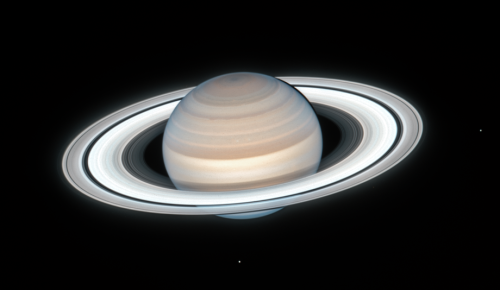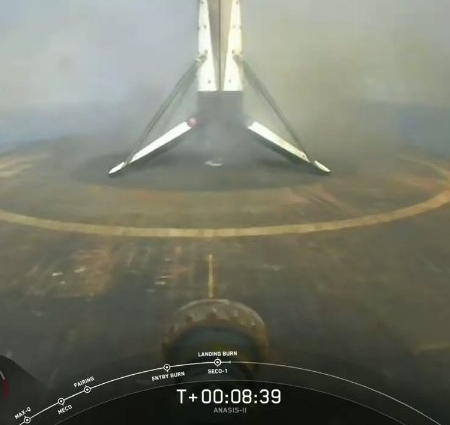A July 4th Hubble image of Saturn

Click for full image, annotated.
Cool image time! The photo to the right, cropped and reduced to post here, was taken by the Hubble Space Telescope on July 4, 2020, and shows Saturn, its rings, plus several moons, in all their glory.
The dot near the bottom center is Enceladus. The dot at center right is Mimas. If you click on the annotated full image it will show the locations of several other smaller moons much harder to see.
This new Saturn image was taken during summer in the planet’s northern hemisphere.
Hubble found a number of small atmospheric storms. These are transient features that appear to come and go with each yearly Hubble observation. The banding in the northern hemisphere remains pronounced as seen in Hubble’s 2019 observations, with several bands slightly changing color from year to year. The ringed planet’s atmosphere is mostly hydrogen and helium with traces of ammonia, methane, water vapor, and hydrocarbons that give it a yellowish-brown color.
Hubble photographed a slight reddish haze over the northern hemisphere in this color composite. This may be due to heating from increased sunlight, which could either change the atmospheric circulation or perhaps remove ices from aerosols in the atmosphere. Another theory is that the increased sunlight in the summer months is changing the amounts of photochemical haze produced.
The distance across from one end of the rings to the other is about 150,000 miles, about two thirds the distance from the Earth to the Moon.

Click for full image, annotated.
Cool image time! The photo to the right, cropped and reduced to post here, was taken by the Hubble Space Telescope on July 4, 2020, and shows Saturn, its rings, plus several moons, in all their glory.
The dot near the bottom center is Enceladus. The dot at center right is Mimas. If you click on the annotated full image it will show the locations of several other smaller moons much harder to see.
This new Saturn image was taken during summer in the planet’s northern hemisphere.
Hubble found a number of small atmospheric storms. These are transient features that appear to come and go with each yearly Hubble observation. The banding in the northern hemisphere remains pronounced as seen in Hubble’s 2019 observations, with several bands slightly changing color from year to year. The ringed planet’s atmosphere is mostly hydrogen and helium with traces of ammonia, methane, water vapor, and hydrocarbons that give it a yellowish-brown color.
Hubble photographed a slight reddish haze over the northern hemisphere in this color composite. This may be due to heating from increased sunlight, which could either change the atmospheric circulation or perhaps remove ices from aerosols in the atmosphere. Another theory is that the increased sunlight in the summer months is changing the amounts of photochemical haze produced.
The distance across from one end of the rings to the other is about 150,000 miles, about two thirds the distance from the Earth to the Moon.




